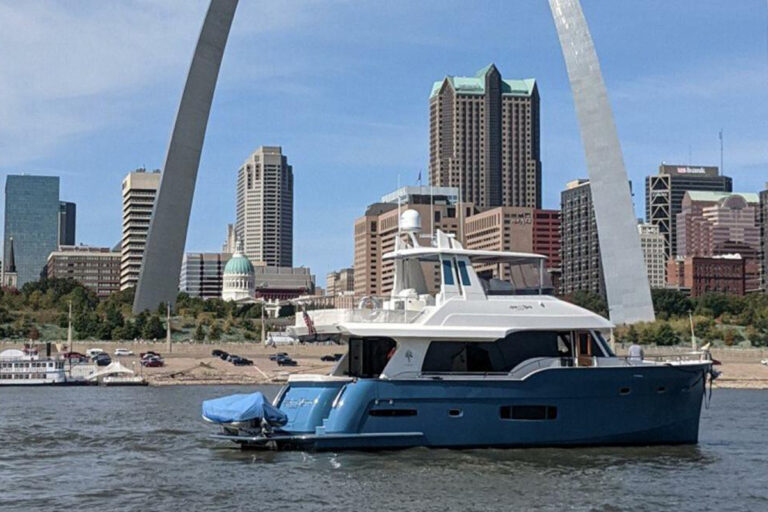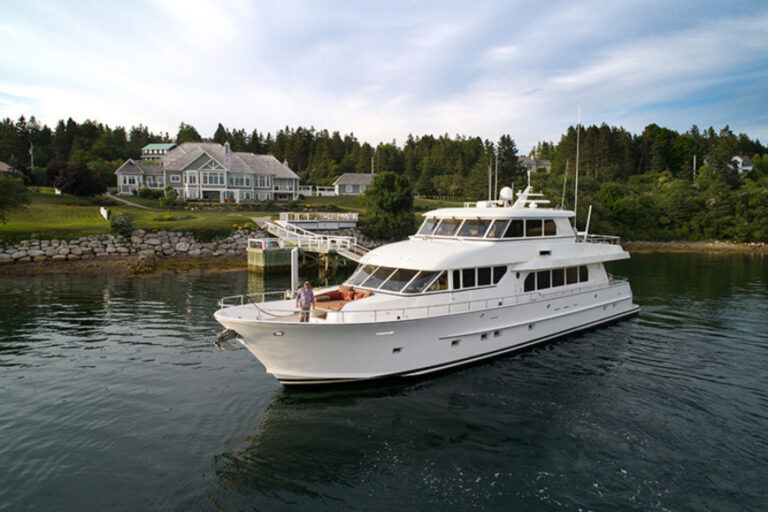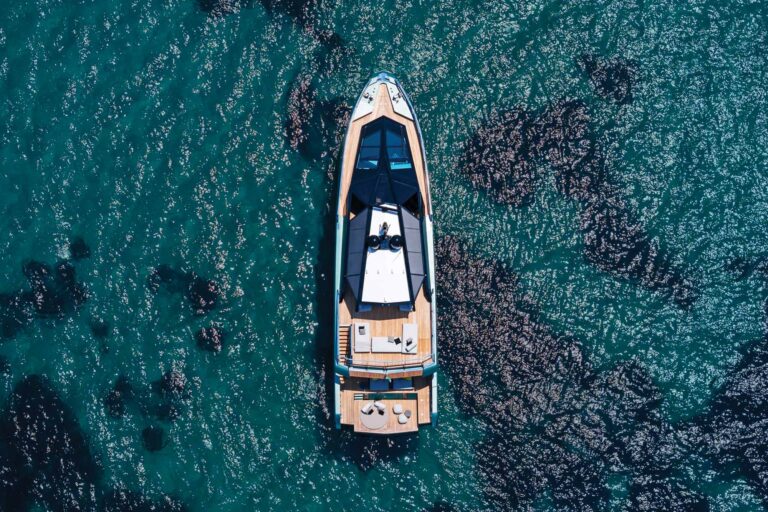During a casual day sail, the Swan 70’s precise steering, quick reflexes and exceptional balance will go to your head. You may wonder how you got to be such a sensitive helmsman.
I did, even though I tacked half a dozen times before I got it exactly right, falling off just enough to accelerate, then heading up while the trimmers hardened up the mainsail and jib. Before I could say “Germán Frers Naval Architecture & Engineering, the GPS showed 9.5 knots over the ground-this in a true wind speed of 11.5 knots and at the apparent wind angle of 33 degrees.
This 70, Strabo, was the first to be delivered in the United States. I met her in Annapolis, Maryland, this past October. She swung patiently on her mooring at the deepest extremities of the mooring field in Annapolis Harbor, banished there by the 13-foot draft of her optional regatta keel.
Howling winds 24 hours before had led a weather front through the area, confusing this October Tuesday about what sort of day it wanted to be. Clouds the color of tarnished pewter battled the sun, working the apparent temperature like a tournament yo-yo. Never mind the schizophrenic weather. The winds, at least, knew enough to blow up Chesapeake Bay at a respectable 12 to 17 knots, occasionally gusting to 20. After about an hour of tacking and jibing to give me a sense of the 70’s personality, we headed toward Baltimore, this yacht’s home.
What impressed me even more than her speed was her ability to nudge double digits wearing her cruising sails, towing the dinghy and carrying a fair complement of stores, water and fuel-plus five adults. Beautifully cut and drawing like gangbusters, the cruising main, compared with the racing sail, gives away significant area in the roach, and it doesn’t hold its shape as well as the exotic laminated racing main. The same criticism holds true for the headsail, and it suffers a bit from being cut to roll up nicely on a furling system. Skipper Dan Mullervy reckoned we had forfeited a knot or two of top speed, thanks to the sails and dinghy.
I generally need about an hour at the helm to acquaint myself with a boat I’ve never sailed. On this day, I learned the Swan 70 is very responsive, and until I became accustomed to the helm, I over-steered in the tacks and jibes. I discovered also that she tacks fast enough to get ahead of the crew in the relaxed atmosphere of a day sail. Her steering is dead-nuts accurate and quick (two turns from hard over to hard over), and her course so predictable I would not hesitate a second to pick up a mooring under sail or aggressively dice for the best starting position at the line. Precision of this magnitude comes in part from the deep rudder and keel, both of high aspect ratio and shaped to achieve the best possible lift-to-drag ratio. The balance a boat needs to perform like the 70 comes from the placement of the appendages and rig relative to each another. Frers and the riggers got this one exactly right.
Given the chance, the 70 makes her own wind. In 15 knots of true wind she brings the apparent wind forward and wants her sails trimmed to suit. Her light weight and shallow canoe body will encourage her to surf downwind under spinnaker.
Though Germán Frers has worked magic for a wide variety of builders, his firm and Oy Nautor Ab have enjoyed a long and wonderfully symbiotic relationship, producing sailing yachts of delicate beauty and remarkable performance. A 70-foot sailing yacht is a massive structure and careless treatment of the sheerline, coachroof, bow and stern can produce something that resembles an escapee of Dr. Frankenstein’s laboratory. As always, Frers and Nautor have given us floating art.
Frers files off the businesslike edge of his high-performance yachts by raking the stem a tad and letting the knuckle at the entry stand slightly above the water. The run ends in a short counter stern, capped by an elegantly arced reverse transom. He picks up the forward thrust of the transom in the after terminus of the cockpit coamings and coachroof. Teak decking, 9 millimeters nominal thickness and vacuum-bagged to the composite deck mold, finishes Strabo the way a pair of light-gray suede gloves finishes the groom’s costume.
Swan and Frers have made the 70 a genuine dual-purpose yacht. You’ll find no hint belowdecks that she has a sail area/displacement ratio of 25 (lots of power) and a displacement/DWL ratio of 125 at light-load displacement-a smidge to the heavy side of ultra-light. In fact, the handcrafted teak interior encourages one to put up his feet at the end of a day’s sailing, sip a single-malt Scotch and listen to the Dave Brubeck Quartet.
Beneath this lovely teak, though, lies one of the secrets to the 70’s dash: Swan has made all of Strabo‘s furniture from teak veneer over foam or Nomex honeycomb core. Some panels are teak veneer over marine plywood, which are still lighter than solid teak. In the interest of safety, Swan has eliminated the sharp corners in the joinerwork. Any transition that could be an edge wears as soft a radius as the dimensions allow, so if you fall against a piece of furniture in a knockdown, you’ll likely not suffer a bloody knockout.
Strabo first revealed her serious cruising intentions in the deep, U-shape galley. I uncovered a dishwasher, four-burner propane stove with oven, and an upright refrigerator (7 cubic feet) to the left of the stove at eye level. A bank of drawers beneath the fridge holds flatware and other utensils. A holding-plate freezer embedded in the cabinetry loads from the top and is large enough to keep an active crew fed for a week.
The saloon should easily accommodate the standard guest list of six adults. Chairs and a built-in settee allow four people to spread out at the dining table and, in port, bring the serving dishes to the program. The dinette will comfortably accommodate six adults, but they’ll have to mind their elbows and leave the serving dishes in the galley. If you want to use the table at sea, you’ll have to request higher fiddles than the ones Swan provides as standard. I’d also want higher fiddles on all the counters.
Swan had crewed charter in mind when it requested the 70 from Frers, and he obligingly placed the master stateroom as far aft as good weight distribution and use of space allowed. Strabo‘s owner requested a queen berth on the centerline, which required offsetting the companionway that leads to the after cockpit. This alteration still left room on the starboard side for upper-and-lower sea berths. Frers put the guest staterooms right forward of the saloon. Each of the forward cabins has a head, but the two crewmembers-whose accommodations are in the fo’c’sle-also have access to the starboard head. The panel between the two forward staterooms removes to convert the area to a one large VIP suite.
As I explored the accommodations, I found myself wishing for more natural light and eye-level portlights. I’m just 5 feet, 6 inches tall, and the only portlights on the 70 are in the sides of the trunk cabin, nearly a foot above my head. Though the interior was lovely, it felt a bit like a cave to me. I’d want portlights let into the topsides so I could see out. On the other hand, I’d have to give up quite a lot of stowage above the counter.
In keeping with the dual-purpose nature of the 70, Swan has made a lot of the interior removable: The dining table splits into two parts, and the chairs in the saloon and panels between the forward staterooms are small enough to pass through the companionway.
Topside, all hatches are flush, and the deck has been swept clear of dorades and other excrescences that threaten to trip up the crew. The jib sheets lead to tracks mounted hard against the coachroof, allowing unobstructed passage along the side decks and tight sheeting angles for optimum performance to windward. Members of the foredeck crew ought to love the wide-open space, but they may object to the absence of bulwarks to help them stay on the heeling, pitching deck.
Swan has always promoted the two-cockpit deck arrangement, and the 70 continues this tradition. A pair of beautifully made carbon/wood steering wheels dominates the after cockpit. A step away from the helm on the coamings are the electrically powered primary winches and manual secondary/mainsheet winches. Their location allows the cruising helmsman to easily engage the autopilot and tweak the trim of the main and jib. The raised area of the cockpit forward of the wheels has all the space the crew needs to man the winches on race day without crowding the helmsman.
The carbon rig by Offshore Spars has four sets of swept spreaders and a split hydraulic backstay. This setup eliminates the need for running backstays and greatly simplifies tacking and jibing.
Swan offers something besides great sailing and luxurious cruising: value. If you keep your Swan long enough, you may get her original selling price when you want to move on. In this case, that is $3,900,200 base FOB Finland. Figure another $60,000 to receive the boat in the U.S. Ignoring everything else the Swan 70 offers, the pure joy of sailing such a well-balanced, fast and responsive yacht is worth the price of admission.
Contact: Swan New York, (203) 425-9700; sales@swan-newyork.com; www.swan-newyork.com. For more information, contact: (866) 922-4877









